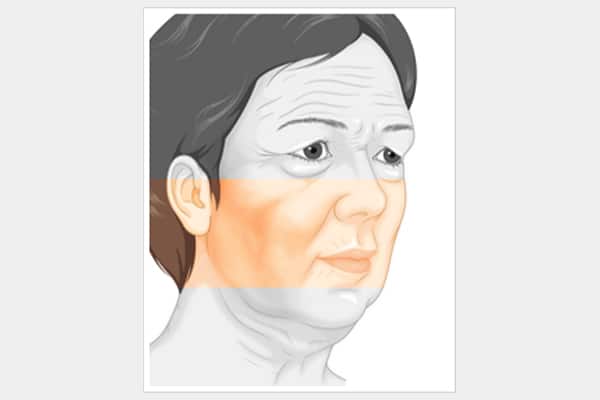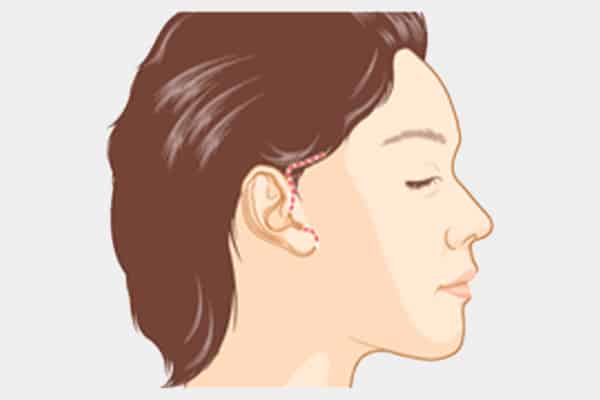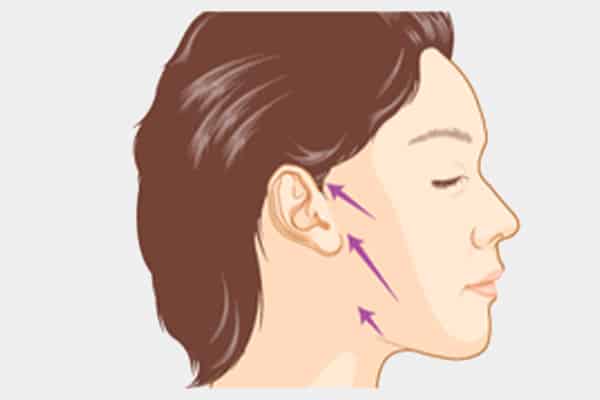
Facelift Surgery

Procedure Time
3 – 4 Hours

Anaesthesia
General Anaesthesia

Recovery Period
14 – 18 Days

Stitch Removal
7 Days Post-op
What is Facelift Surgery?
A Facelift Surgery is a cosmetic surgery procedure that is used for creating a more youthful facial look. This procedure can effectively reduce sagging skin on the forehead, cheeks and jawline while fixing other facial changes that come with age.
The natural process of ageing causes facial tissues to lose their elasticity which the skin gets loose and wrinkles start appearing on the face. The soft facial tissue, the fascia (SMAS) that supports it, and the connected ligaments start stretching as their elasticity is lost. The drooping tissue as well as the loosening skin that surrounds the cheeks creates sort of a hollow look at the front of cheekbones. This leads to the formation of wrinkles, double chin, or deepened nasolabial lines.
Depending on the skin condition of an individual and the effect of ageing on their appearance, a facelift surgery that tightens the SMAS layer, muscles and removal of excess skin may be needed to create a younger look.

Who Needs Facelift Surgery?
Facelift surgery is recommended for individuals with:
- Deep wrinkles everywhere on their face.
- Extremely saggy cheeks, chin and jawline because of aging.
- No satisfaction from other lifting procedures.
- A desire to get more distinct result.
- No success in improving wrinkles through thread lifting procedures because of severe aging effects.
Face Lift Treatment Sites

Types of Facelift Procedures Available
There are three types of facelift in Singapore procedures available today. These include:

1. Endotine Facelift
The Endotine Facelift surgery uses a dissolvable implant for effectively elevating and fixating soft tissue at a desired position. The implant is affixed at various contact points. It can effectively fix wrinkles and any sagging skin issues. In addition, the procedure can help with even tissue distribution to restore those youthful facial contours.
The Endotine Facelift surgery is recommended for the treatment of mild-to-moderate skin laxity problems targeting mid-face, neck, forehead, cheek, and jowls. The procedure can be helpful in smoothing wrinkles, crepey skin texture that results from uneven fat tissue distribution, and lighten nasolabial folds. It can also improve one’s facial contours. Post-procedure bruising and swelling usually subsides in 7-10 days and the patients can start their routine activities in 14 days time.
2. MACS Lift or Mini Facelift
This Facelift procedure helps with mid-facial skin laxity problems and leaves minimal scars behind. Individuals who start exhibiting droopy jowls, had previously undergone lifting procedures, or wish to have quicker post-procedure healing are the best candidates for Mini Facelift surgery.
Unlike other traditional procedures, mini facelift surgery uses short-scar endoscopic facelift method to vertically reposition any underlying muscles as well as the fat tissue in mid-face. This facelift surgery can give a youthful look to the patients’ cheeks and brows while improving their mid-face contours. It also eliminates any hollowness that is caused by tissue migration. Depending on the patient’s condition, additional fat grafting surgery may be needed for plumping up any areas with volume loss to achieve a more rejuvenated look.
Generally, it takes 10-14 days for bruising and swelling to subside. Patients can return to their daily activities in 3 weeks time.

Step 1
An incision is made behind the hairline, allowing the surgeon to access the soft tissues around the mid-face area.

Step 2
Sutures are used to correct the position of the loose tissues and fat pads before they are anchored to the deep temporal fascia.

Step 3
The incision is closed with sutures and they remain hidden behind the hairline. Cheek area appears rejuvenated and lifted.
3. Traditional Facelift (Rhytidectomy)
The traditional facelift surgery is a comprehensive procedure that can address several ageing problems. It helps rejuvenate all the areas between the patient’s forehead and neck, bringing about long lasting results to make people look 5-10 years younger, at least. A full facelift is recommended to patients with serious skin laxity issues, excessive facial skin, deep facial creases, or uneven distribution of the subcutaneous tissue. This surgical procedure is also advised when minimal results are achieved from any other facelift surgery methods used previously.

Combining Facelift Surgery With Lasers Or Injectables
Frequently Asked Questions (FAQ) about Facelift Surgery in Singapore
What Is Considered The Ideal Age To Undergo A Facelift Procedure?
The facelift procedure depends on the condition of the facial skin rather than the age. Aging is a process that differs from one individual to another. The type of procedure is tailored to the patient’s unique set of facial features and skin type.
Older people (regardless of age) with good health can get to enjoy facial rejuvenation benefits via a facelift procedure. In the majority of the cases, no patients are rejected for treatment on the basis of old age.
Who Is An Ideal Candidate For Facelift?
The proper age for when a person should undergo a facelift varies from person to person. As the aging experiences of each person are different, a facelift procedure is customized to a patient’s unique facial characteristics. It ensures that a person can benefit from a facelift to achieve a balanced, natural-looking facial appearance.
The ideal candidate must:
- have good general health
- have excessive skin on the face and neck
Can A Facelift Make Me Look A Lot Younger?
A facelift procedure can “set the clocks back” for you. The aging signs (sagging, loose skin, weakened muscles, and diminished bone density) can subside to some extent but the procedure cannot stop the aging process. You can achieve a younger, fresher look but the change relies on the extent of skin damage that has already been done.
The environment casts its impact on your skin. Your skin texture and bone structure can be affected by environmental toxins, skin exposure, and smoking. Therefore, to keep your skin rejuvenated after the surgery you must take good care.
Will My Skin Look Stretched After The Surgery?
The way your skin looks postoperatively very much relies on the skills and technique used for the procedure. The modern facelift is no longer just a simple procedure of trimming the excess skin and closing the surgical cuts. Unlike old methods, today’s procedures impart multiple benefits and result in a more natural look:
- Tightening of underlying facial muscles
- Restoration of lost volume
- Removal of excess skin
The patients may be recommended to undergo neck lift surgery too. This is to avoid the disparity between facial and neck skin. In the neck lift procedure, sagging neck skin (aka turkey wattle) is restored to its tight and fresh form.
What Is The Anesthesia Of Choice?
The patient get to choose between two types of anesthesia:
- Local anesthesia with IV sedation
- General anesthesia
A pre-operative consultation is done by the surgeon with the patient and the pros and cons of all the options are discussed. The extent of work is the deciding factor for anesthesia selection.
The decision is also shadowed by the advice of a board-certified anesthesiologist.
How Long Does The Surgery Take?
On average a facelift procedure lasts for 3 hours or so. However, the duration of the surgical procedure varies from one individual to another and is dependent on these factors:
- The extent of the changes to be undertaken
- Type of technique used
For example, a mid-face lift procedure lasts for a couple of hours. When going for extensive surgical combinations such as facelift neck, neck lift + eye lift, the surgical procedure can take well over 5 hours.
Are The Facelift Scars Visible To Others?
The majority of incision lines given during surgery are hidden behind the hairline or in the natural creases. The scars from the operation are noticeable in the initial days of recovery. Several months after the procedure, scars start to fade and blend into the surrounding skin. They become less and less noticeable overtime.
Where possible, the plastic surgeon tried to avoid giving big incisions. So, a smaller incision is faster to heal and the scar is smaller too.
When Can I Start A Normal Life After Surgery?
All surgical procedures take time to heal. In order to carry out proper care for your facelifted skin, you should limit your activities for a few days initially. You can follow these instructions for better and quicker recovery:
- Do not do exercise for at least 2-3 weeks after surgery
- Keep your head elevated when resting
- Relax as much as you can in the 1st week of healing
- Gently wash your face (after dressing removal)
- Avoid sun exposure
You can return to normal life working by following these precautions. Usually, patients can resume work 2 to 3 weeks after the surgery.
How Much Time Is Required For Full Recovery?
The healing rates vary between patients and are greatly affected by the age of the patient. Young patients have a faster healing rate while older patients take longer. You can experience the following healing stages:
First 10 Days
This is the first stage of healing. In this stage, it is common to experience a rise in swelling which it typically peaks around the fourth day after the procedure. The swelling will start to subside gradually and continue to improve over the next week.
10 – 14 Days
The next stage lasts for a couple of weeks after the first stage. By this point, there is an evident improvement in the skin. Majority of the swelling and the bruising would have subsided, therefore, patients start to resume social interactions by this stage. The remnant swelling which will still result in slight puffiness will take a longer time to subside fully.
14 Days – 6 Months
The process of healing continues to proceed at a slow rate from 3 weeks to 6 months. In most cases, maximum results are achieved after 3 months (90%).
What Can I Expect?
You can discuss your issues with the surgeon who analyzes your skin tone, texture, and quality along with the extent of the issue. Based on the medical history, age, and facial features, the surgeon recommends the best treatment option.
Plastic surgeons give you a realistic approach towards the changes that can be brought about. The limitations to your (if any) will be discussed prior to the treatment to avoid any inconvenience later on. If you are a suitable candidate for the facelift the doctor will tell you so. Otherwise, he would recommend other procedures such as thread lift for your consideration.
How To Prepare For A Facelift?
Your surgeon may recommend the following before the surgery:
- Stop certain medications days prior to surgery (including blood thinners, and anti-inflammatory drugs, etc.)
- Stop taking any herbal supplements
- Avoid smoking
These precautions allow for a better chance of quicker healing and minimize surgical risk.
